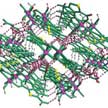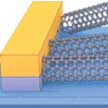Showing Spotlights 73 - 80 of 240 in category All (newest first):
 Motivated by the high level of flexibility exhibited by spider webs, scientists have developed a novel design for highly flexible and sensitive piezoresistive sensors based on an elastomer-filled graphene-woven fabric (E-GWF) structure. This technique mimics the distinct core-shell structure of spider webs. This fabrication method could also be extended to other 1D and 2D materials for many emerging practical applications. In addition to excellent sensing capability, the E-GWF also shows unusual switching behavior at large strains owing to the reversible cracking and reconnection of interconnected graphene tubes.
Motivated by the high level of flexibility exhibited by spider webs, scientists have developed a novel design for highly flexible and sensitive piezoresistive sensors based on an elastomer-filled graphene-woven fabric (E-GWF) structure. This technique mimics the distinct core-shell structure of spider webs. This fabrication method could also be extended to other 1D and 2D materials for many emerging practical applications. In addition to excellent sensing capability, the E-GWF also shows unusual switching behavior at large strains owing to the reversible cracking and reconnection of interconnected graphene tubes.
Jan 17th, 2019
 Researchers have demonstrated materials and techniques to achieve highly sensitive flexible biosensors integrated with metal-organic frameworks (MOFs) - essentially inorganic-organic hybrids that contain repeated metal ions connected with organic ligands. These high-throughput flexible devices can achieve highly specific and sensitive electrochemical detection and can be used to monitor neurotransmitters and nutrients in vivo.
Researchers have demonstrated materials and techniques to achieve highly sensitive flexible biosensors integrated with metal-organic frameworks (MOFs) - essentially inorganic-organic hybrids that contain repeated metal ions connected with organic ligands. These high-throughput flexible devices can achieve highly specific and sensitive electrochemical detection and can be used to monitor neurotransmitters and nutrients in vivo.
Jun 13th, 2018
 In new work, researchers explore inexpensive, biodegradable and daily-waste eggshell membrane as a novel bio-piezoelectric material for harvesting green energy. The uniqueness of our work lies in the novelty of directly utilizing natural eggshell membranes as efficient piezoelectric material. This simple, innovative approach could provide huge benefits for research in future energy science, especially with regard to in vivo biomedical applications.
In new work, researchers explore inexpensive, biodegradable and daily-waste eggshell membrane as a novel bio-piezoelectric material for harvesting green energy. The uniqueness of our work lies in the novelty of directly utilizing natural eggshell membranes as efficient piezoelectric material. This simple, innovative approach could provide huge benefits for research in future energy science, especially with regard to in vivo biomedical applications.
Jun 12th, 2018
 Mimicking the exciting skin structure and function, researchers have designed hierarchical nanoporous and interlocked micro ridge structured polymers with gradient stiffness. The gradient elastic modulus of interlocked and micro ridge structured polymers effectively transfers the external stress and induces the large frictional contact between two polymeric layers, which facilitates their use in self-powered triboelectric sensors. Furthermore, the additional nanoporous structures in the micro ridge structured polymers lead to the effective variation of both volume and gap distance between opposing surfaces without the need of bulky spacers, resulting in ultrathin and flexible triboelectric sensors for applications in wearable electronics.
Mimicking the exciting skin structure and function, researchers have designed hierarchical nanoporous and interlocked micro ridge structured polymers with gradient stiffness. The gradient elastic modulus of interlocked and micro ridge structured polymers effectively transfers the external stress and induces the large frictional contact between two polymeric layers, which facilitates their use in self-powered triboelectric sensors. Furthermore, the additional nanoporous structures in the micro ridge structured polymers lead to the effective variation of both volume and gap distance between opposing surfaces without the need of bulky spacers, resulting in ultrathin and flexible triboelectric sensors for applications in wearable electronics.
May 22nd, 2018
 Sepsis is the body's extreme response to an infection. It is life-threatening condition in which bacteria or fungi multiply in a patient's blood - often too fast for antibiotics to help. Without timely treatment, sepsis can rapidly cause tissue damage, organ failure, and death. A critical unmet need in combating sepsis is the lack of accurate early biomarkers that can alert clinicians to a potential life-threatening situation and allow them to take preventative action. In a new study, researchers report the development of a point-of-care platform for rapid sepsis detection, called IBS (integrated biosensor for sepsis).
Sepsis is the body's extreme response to an infection. It is life-threatening condition in which bacteria or fungi multiply in a patient's blood - often too fast for antibiotics to help. Without timely treatment, sepsis can rapidly cause tissue damage, organ failure, and death. A critical unmet need in combating sepsis is the lack of accurate early biomarkers that can alert clinicians to a potential life-threatening situation and allow them to take preventative action. In a new study, researchers report the development of a point-of-care platform for rapid sepsis detection, called IBS (integrated biosensor for sepsis).
Apr 12th, 2018
 Over the past few decades, researchers have developed various optical voltage sensing probes in order to overcome the highly invasive nature of electrode-based techniques. These voltage sensing mechanisms can be hampered by some combination of limitations including low sensitivity, slow kinetics, or heavy capacitive loading. This has motivated a group of researchers to explore DNA nanotechnology for developing novel optical voltage sensing nanodevices that convert a local change of electric potential into optical signals.They now report that a voltage can be read out in a nanopore with a dedicated F�rster resonance energy transfer (FRET) sensor on a DNA origami.
Over the past few decades, researchers have developed various optical voltage sensing probes in order to overcome the highly invasive nature of electrode-based techniques. These voltage sensing mechanisms can be hampered by some combination of limitations including low sensitivity, slow kinetics, or heavy capacitive loading. This has motivated a group of researchers to explore DNA nanotechnology for developing novel optical voltage sensing nanodevices that convert a local change of electric potential into optical signals.They now report that a voltage can be read out in a nanopore with a dedicated F�rster resonance energy transfer (FRET) sensor on a DNA origami.
Mar 26th, 2018
 The detection of carbon monoxide (CO) in the air is a vital issue, as CO is a highly toxic gas and an environmental pollutant. Carbon monoxide is poisonous because it blocks the binding site for oxygen in hemoglobin. It is exactly this principle - a porphyrin ring with a central iron or cobalt atom that the poisonous gas attaches to - that can be used to implement sensors to warn against carbon monoxide. While carbon monoxide sensors have been extensively researched and commercialized, none make use of a molecule that can be voltage-activated using a newly reported method.
The detection of carbon monoxide (CO) in the air is a vital issue, as CO is a highly toxic gas and an environmental pollutant. Carbon monoxide is poisonous because it blocks the binding site for oxygen in hemoglobin. It is exactly this principle - a porphyrin ring with a central iron or cobalt atom that the poisonous gas attaches to - that can be used to implement sensors to warn against carbon monoxide. While carbon monoxide sensors have been extensively researched and commercialized, none make use of a molecule that can be voltage-activated using a newly reported method.
Dec 20th, 2017
 Moderate exposure to sunlight has significant health benefits, however, exposure to ultraviolet (UV) radiation also is a major risk factor for most skin cancers. That means that, while moderate exposure to sunlight is recommended, there is a fine line to walk between beneficial and harmful amounts of UV exposure. To take the guesswork out of assessing the exposure to damaging UV rays, several wearable consumer UV sensors have already hit the market. Researchers have now proposed a simple and low-cost stick-on nanoplasmonic patch made of optically active silver nanoparticles embedded in a film of nanopaper. The patch changes color once it has been exposed to a certain amount of UV light.
Moderate exposure to sunlight has significant health benefits, however, exposure to ultraviolet (UV) radiation also is a major risk factor for most skin cancers. That means that, while moderate exposure to sunlight is recommended, there is a fine line to walk between beneficial and harmful amounts of UV exposure. To take the guesswork out of assessing the exposure to damaging UV rays, several wearable consumer UV sensors have already hit the market. Researchers have now proposed a simple and low-cost stick-on nanoplasmonic patch made of optically active silver nanoparticles embedded in a film of nanopaper. The patch changes color once it has been exposed to a certain amount of UV light.
Nov 22nd, 2017
 Motivated by the high level of flexibility exhibited by spider webs, scientists have developed a novel design for highly flexible and sensitive piezoresistive sensors based on an elastomer-filled graphene-woven fabric (E-GWF) structure. This technique mimics the distinct core-shell structure of spider webs. This fabrication method could also be extended to other 1D and 2D materials for many emerging practical applications. In addition to excellent sensing capability, the E-GWF also shows unusual switching behavior at large strains owing to the reversible cracking and reconnection of interconnected graphene tubes.
Motivated by the high level of flexibility exhibited by spider webs, scientists have developed a novel design for highly flexible and sensitive piezoresistive sensors based on an elastomer-filled graphene-woven fabric (E-GWF) structure. This technique mimics the distinct core-shell structure of spider webs. This fabrication method could also be extended to other 1D and 2D materials for many emerging practical applications. In addition to excellent sensing capability, the E-GWF also shows unusual switching behavior at large strains owing to the reversible cracking and reconnection of interconnected graphene tubes.
 Subscribe to our Nanotechnology Spotlight feed
Subscribe to our Nanotechnology Spotlight feed





